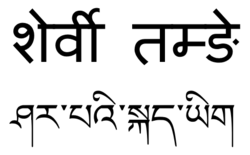You can help expand this article with text translated from the corresponding article in Nepali. (August 2018)Click [show] for important translation instructions.
|
| Sherpa | |
|---|---|
| ཤར་པའི་གཏམश्यार्वी तामབོད་གཏམपो/पे ताम्, śērwī tamṅē ཤར་པའི་སྐད་ཡིག, shar pa'i skad yig | |
 'Sherpa' in Devanagari and Tibetan scripts | |
| Native to | Nepal, India, China, Bhutan |
| Region | Nepal, Sikkim |
| Ethnicity | Sherpa |
Native speakers | 140,000 (2011 & 2021 census) [1] |
| Tibetan, Devanagari | |
| Official status | |
Official language in | |
| Language codes | |
| ISO 639-3 | xsr |
| Glottolog | sher1255 |
| ELP | Sherpa |
Sherpa (also Sharpa, Sherwa, or Xiaerba) is a Tibetic language spoken in Nepal and the Indian state of Sikkim, mainly by the Sherpa. The majority speakers of the Sherpa language live in the Khumbu region of Nepal, spanning from the Chinese (Tibetan) border in the east to the Bhotekosi River in the west. [3] About 127,000 speakers live in Nepal (2021 census), some 16,000 in Sikkim, India (2011), and some 800 in the Tibetan Autonomous Region (1994). Sherpa is a subject-object-verb (SOV) language. Sherpa is predominantly a spoken language, although it is occasionally written using either the Devanagari or Tibetan script. [3]
